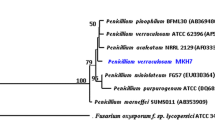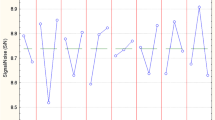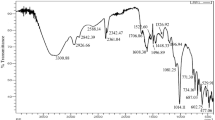Abstract
R-(+)-limonene is an abundant and non-expensive by-product of the citrus industry and is, therefore, a suitable starting material for the production of natural flavor and fragrance compounds. The biotransformation of R-(+)-limonene to R-(+)-α-terpineol by Fusarium oxysporum 152b has already been reported, although the influence of the main process parameters on the production has not yet been evaluated. In this paper, a Plackett-Burman screening design was used to define the effects of the medium composition (glucose, peptone, yeast extract, malt extract and pH), the presence of a co-substrate (biosurfactant), the cultivation conditions (temperature, agitation), the substrate concentration and the inoculum/culture medium ratio on the absolute amount of R-(+)-α-terpineol resulting from this biotransformation. The process conditions were further optimized applying response surface methodology (RSM). The volatiles were extracted using a SPME device and were subsequently quantified by GC-FID and identified by GC-MS. The best results were obtained using 0.5% (v/m) R-(+)-limonene in pure distilled water as the culture medium with an inoculum/culture medium ratio of 0.25 (m/m) and 72 h cultivation at 26 °C/240 rpm. Under these conditions the concentration of R-(+)-α-terpineol in the culture medium reached 2.4 g L−1, a production almost six times greater than in earlier trials. The presence of a biosurfactant (0−500 mg L−1) did not significantly increase the yield.



Similar content being viewed by others
References
Adams A, Demyttenaere JCR, N De Kimpe (2003) Biotransformation of (R)-(+)- and (S)-(–)-limonene to alpha-terpineol by Penicillium digitatum—investigation of the culture conditions. Food Chem 80:525–534
Agrawal R, Joseph R (2000) Optimization of conditions for the biotransformation of alpha pinene to verbenone by a Penicillium sp. J Food Sci Technol 37:430–432
Bauer K, Garbe D, Surburg H (2001) Common fragrance and flavor materials: preparation, properties and uses. 4th ed. Wiley-VCH, Weinheim
Berger RG, De Bont JAM, Eggink G, Da Fonseca MM, Gehreke M, Gros J-B, Van Keulen F, Krings U, Larroche C, Leak D, Van Der Werf M (1999) Biotransformations in the flavour industry. In: Swift KAD (ed) Current topics in flavours and fragrances. Towards a new millennium of discovery. Kluwer Academic Publishers, London, pp 139–170
Bicas JL, Pastore GM (2007) Isolation and screening of d-limonene-resistant microorganisms. Braz J Microbiol 38:563–567
Bognolo G (1999) Biossurfactants as emulsifying agents for hydrocarbons. Colloid Surf 152:41–52
Cadwallader KR, Braddock RJ, Parish ME, Higgins DP (1989) Bioconversion of (+)-limonene by Pseudomonas gladioli. J Food Sci 54:1241–1245
Cadwallader KR, Braddock RJ, Parish ME (1992) Isolation of α-terpineol dehydratase from Pseudomonas gladioli. J Food Sci 57:241–244 and 248.
Carrillo C, Teruel JA, Aranda FJ, Ortiz A (2003) Molecular mechanism of membrane permeabilization by the peptide antibiotic surfactin. Biochem Biophys Acta 1611:91–97
Çelik D, Bayraktar E, Mehmetoğlu Ü (2004) Biotransformation of 2-phenylethanol to phenylacetaldehyde in a two-phase fed-batch system. Biochem Eng J 17:5–13
Chatterjee T, Bhattacharyya DK (2001) Biotransformation of limonene by Pseudomonas putida. Appl Microbiol Biotechnol 55:541–546
Crowell P (1999) Prevention and therapy of cancer by dietary monoterpenes. J Nutr 129:775S–778S
Demyttenaere JCR, Van Belleghem K, De Kimpe N (2001) Biotransformation of (R)-(+)- and (S)-(−)-limonene by fungi and the use of solid phase microextraction for screening. Phytochemistry 57:199–208
Duetz WA, Bouwmeester H, Van Beilen JB, Witholt B (2003) Biotransformation of limonene by bacteria, fungi, yeasts, and plants. Appl Microbiol Biotechnol 61:269–277
Fontanille P, Larroche C (2003) Optimization of isonovalal production from alpha-pinene oxide using permeabilized cells of Pseudomonas rhodesiae CIP 107491. Appl Microbiol Biotechnol 60:534–540
Gershenzon J, Dudareva N (2007) The function of terpene natural products in the natural world. Nat Chem Biol 3:408–414
Gerson DF (1993) The biophysics of microbial surfactants: growth on insoluble substrates. In: Kosaric N (ed) Surfactants: production, properties, applications. Marcel Dekker Inc., New York, pp 269–286
Jacques P, Hbid C, Destain J, Razafindralambo H, Paquot M, Pauw E, Thonart P (1999) Optimization of biosurfactant lipopeptide production from Bacillus subtilis S499 by Plackett-Burman design. Appl Biochem Biotechnol 77:223–233
Jönsson B, Lindman B, Holmberg K, Kronberg B (1998) Association of surfactants. In: Jönsson B, Lindman B, Holmberg K, Kronberg B (eds) Surfactants and polymers in aqueous solution. Wiley, New York, pp 33–60
Jun M, Jeong W-S, Ho C-T (2006) Health promoting properties of natural flavor substances. Food Sci Biotechnol 15:329–335
Kraidman G, Mukherjee BB, Hill JD (1969) Conversion of D-limonene into an optically active isomer of α-terpineol by a Cladosporium species. Bacteriol Proc 69:63
Krings U, Berger RG (1998) Biotechnological production of flavours and fragrances. Appl Microbiol Biotechnol 49:1–8
Krings U, Hardebusch B, Albert D, Berger RG, Maróstica MR Jr, Pastore GM (2006) Odor-active alcohols from the fungal transformation of α-farnesene. J Agric Food Chem 54:9079–9084
Maróstica MR Jr, Pastore GM (2007) Production of R-(+)-α-terpineol by the biotransformation of limonene from orange essential oil, using cassava waste water as medium. Food Sci 101:345–350
Matthews RF, Braddock RJ (1987) Recovery and application of essential oils from oranges. Food Technol 41:57–61
Melo LLMM, Pastore GM, Macedo GA (2005) Optimized synthesis of citronellyl flavour esters using free and immobilized lipase from Rhizopus sp. Process Biochem 40:3181–3185
Nitschke M, Pastore GM (2006) Production and properties of a surfactant obtained from Bacillus subtilis grown on cassava wastewater. Biores Technol 97:336–341
Onken J, Berger RG (1999) Effects of R-(+)-limonene on submerged cultures of the terpene transforming basidiomycete Pleurotus saidus. J Biotechnol 69:163–168
Prazeres JN, Cruz JAB, Pastore GM (2006) Characterization of alkaline lipase from fusarium oxisporum and the effect of different surfactants and detergents on the enzyme activity. Braz J Microbiol 37:505–509
Rodrigues MI, Iemma AF (2005) Planejamento de experimentos e otimização de processos: uma estratégia seqüencial de planejamentos. Editora Casa do Pão, Campinas, Brazil
Seitz EW (1994) Fermentation production of pyrazines and terpenoids for flavors and fragrances. In: Gabelman A (ed) Bioprocess production of flavor, fragrance, and color ingredients. Wiley, New York, pp 95–134
Sen R, Swaminathan T (1997) Application of response-surface methodology to evaluate the optimum environmental conditions for the enhanced production of surfactin. Appl Microbiol Biotechnol 47:358–363
Sen R, Swaminathan T (2004) Response surface modeling and optimization to elucidate and analyze the effects of inoculum age and size on surfactin production. Biochem Eng J 21:141–148
Serra S, Fuganti C, Brenna E (2005) Biocatalytic preparation of natural flavours and fragrances. Trends Biotechnol 23:193–198
Sheppard JD, Mulligan CN (1987) The production of surfactin by Bacillus subtilis grown on peat hydrolysate. Appl Microbiol Biotechnol 27:110–116
Speelmans G, Bijlsma A, Eggink G (1998) Limonene bioconversion to high concentratiuons of a single and stable product, perillic acid, by a solvent-resistant Pseudomonas putida strain. Appl Microbiol Biotechnol 50:538–544
Tan Q, Day DF (1998) Bioconversion of limonene to α-terpineol by immobilized Penicillium digitatum. Appl Microbiol Biotechnol 49:96–101
Tan Q, Day DF (1998) Organic co-solvent effects on the bioconversion of (R)-(+)-limonene to (R)-(+)-α-terpineol. Process Biochem 33:755–761
Tan Q, Day DF, Cadwallader KR (1998) Bioconversion of (R)-(+)-limonene by P. digitatum (NRRL 1202). Process Biochem 33:29–37
Trytek M, Fiedurek J (2002) Biotransformation of D-limonene to carvone by means of glucose oxidase and peroxidase. Acta Microbiol Pol 51:57–62
Welsh FK (1994) Overview of bioprocess flavor and fragrance production. In: Gabelman A (ed) Bioprocess production of flavor, fragrance, and color ingredients. Wiley, New York, pp 1–17
Acknowledgments
The authors are truly grateful for the valuable suggestions from Prof. Maria Isabel Rodrigues (DEA/FEA−Unicamp, Brazil) and acknowledge Conselho Nacional de Desenvolvimento Científico e Tecnológico (CNPq), Coordenação de Aperfeiçoamento de Pessoal de Nível Superior (CAPES) and Fundação de Amparo à Pesquisa do Estado de São Paulo (FAPESP) for their financial support.
Author information
Authors and Affiliations
Corresponding author
Rights and permissions
About this article
Cite this article
Bicas, J.L., Barros, F.F.C., Wagner, R. et al. Optimization of R-(+)-α-terpineol production by the biotransformation of R-(+)-limonene. J Ind Microbiol Biotechnol 35, 1061–1070 (2008). https://doi.org/10.1007/s10295-008-0383-0
Received:
Accepted:
Published:
Issue Date:
DOI: https://doi.org/10.1007/s10295-008-0383-0




